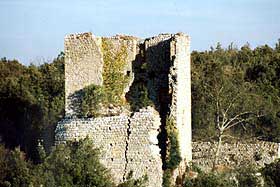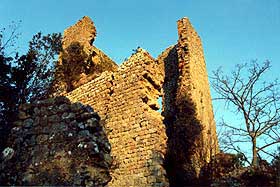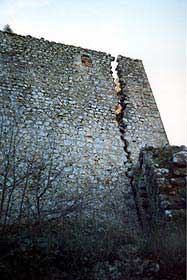Castelvecchio
Photos by Marco Ramerini
 |
 |
| The powerful keep, that defended the main gate of the enclosure-walls, with rests of the surrounded buildings. | |
The settlement of Castelvecchio rise near the top of the mount Cornocchio. It can be reached following a deviation around 2 kilometers west of the road that leads to the 'Castagno del Cornocchio' and from here to Volterra. We arrive at the ruins through a path in the wood. From San Gimignano follow the 'SP.69 di Cellole', after about 8 km. turn right on the 'SP del Cornocchio'.
» Click here for more Photos
» Click here for a Map of the castle
and here for a Location Map
Define only 'Castle' the area where Castelvecchio rises it's rather
restrictive. The settlement is in practice a small fortified city and
inside their defensive structures still rises the ruins of residences
of varied social levels and notable rests of the Parish church of S.Frediano.
The origin of Castelvecchio is collegate with its position, it was in
fact a 'sacred cliff ' of the Etruscan, that were the first to build
in the area. After the decline of the Etruscan civilization the
following Roman period brought to the abandonment of the town,
too isolated from the main roads of communication. Between the end of
the 6th century and the beginning of the following, after the Longobard invasion
of Italy, the hill was rediscovered and strengthened by the northern
invaders in the context of their operations of arrangement and control
of the subjugated territories. We learn from historical sources that
in the 1100 Castelvecchio had practically the actual aspect and that
it was constituted in 'free common'.
From the rests of the residences come up to us we can deduce that the town could give hospitality to around five hundred persons, even if the inhabitants to the time had to be only about hundred, mainly devoted to the agriculture. Perhaps it is between these ruins, more than in other places, that we can realize how was the life in the castles of the Tuscan medieval country: the sentinels from the town walls and from the towers watched over on the people at work in the fields, giving the alarm that let all reenter in hurry to the shelter of the fortifications in case of danger.
Castelvecchio, also being under the protectorate of S.Gimignano, paid
a tribute to the Bishop of the powerful Volterra to maintain good neighborhood
relationship. It was not a subjection but only a forced affairs calculation:
in the case the 'castrum' was attached, Volterra would
have felt in duty to attend in its defense. This situation lasted up
until 1227. However Castelvecchio had the faculty of self-govern on the
base of the arrangements typical of the free-common. Its position, in
the middle between S.Gimignano and Volterra, made of Castelvecchio
the 'needle of the balance', either defensive that offensive, in the
wars between these two big medieval powers.
For this reason in 1208 in Castelvecchio were strengthened the fortifications and reconstructed the city-walls. So the installation became a forerunner strengthened citadel, group of military, religious and civil buildings contained inside a mighty fortified enclosure with elliptical form and a perimeter of around 600 meters.
The 'citadel' was ever conquered in war, but it was twice occupied due to betrayals. The first time in 1250, when the inhabitants of Camporbiano, for motives of neighbour, one night entered the gates and given all to fire and in 1268, when some Ghibelline with false Guelph standarte occupied the castle. In 1308 there was another war between Volterra and S.Gimignano and Castelvecchio, for its strategic position, was the principal objective of the Episcopalian army. The city withstand the siege and became the symbol of the Sangimignanese resistance first and of the victory then, that happened in a open field battle fought a little far from the town walls. Between the enemy cities was arranged a border line three kilometers towards Volterra from the hill of Castelvecchio.
From here begins the decline of Castelvecchio: not being anymore on a
frontier position, it was soon supplanted in the strategic importance
by the fortress built on the new border between 1310 and 1320, the actual
Castel S.Gimignano. In the following years what didn't make the war made
the plague: in 1353 the glorious castle was reduced to a poor village
where lived only a few families of shepherds and woodmen. At the end
of the plague epidemic was tried of to let reborn the suburb and in 1450 was
reconstructed the keep tower, but by now the train of the history was
lost. To worsen the situation came the earthquake of 1452, that damaged
also Florence. The sacred cliff of the Etruscan was definitely abandoned
at the beginnings of the 17th century.
In the wood still remains the rests of the town walls still with the same perimeter of the 1208 and, except for the mentioned reconstruction at the tower of the keep, the citadel is now as it was in the 13th century. We can notice the characteristics of a Longobard settlement transformed in a feudal castle: a powerful square keep with a tower at defense of the main gate, the church, of which ample rests remain (straight in the apse are recognizable traces of the ancient frescos dated 1275), the shed houses between the two centers of the power (feudal and spiritual), two mills and a big cistern for the supply of water able to contain 60.000 liters.
The whole complex is encircled by high walls alternated by square towers built with the characteristic 'Stone of Castelvecchio' that was extracted from the caves in the neighbor and also exported in the near centers. Of these towers the northern and the southern have been torn by the lightning while that of south-west, at the opposite vertex of the main gate, it's today still intact. Who today succeeds in reaching the zone, invaded from the vegetation and at perennial risk of ulterior collapses, walks on the earth consecrated by a mysterious people where the history has confined its ghosts.
From the rests of the residences come up to us we can deduce that the town could give hospitality to around five hundred persons, even if the inhabitants to the time had to be only about hundred, mainly devoted to the agriculture. Perhaps it is between these ruins, more than in other places, that we can realize how was the life in the castles of the Tuscan medieval country: the sentinels from the town walls and from the towers watched over on the people at work in the fields, giving the alarm that let all reenter in hurry to the shelter of the fortifications in case of danger.
 |
| The tower of the keep with the ruins of the gate. |
For this reason in 1208 in Castelvecchio were strengthened the fortifications and reconstructed the city-walls. So the installation became a forerunner strengthened citadel, group of military, religious and civil buildings contained inside a mighty fortified enclosure with elliptical form and a perimeter of around 600 meters.
The 'citadel' was ever conquered in war, but it was twice occupied due to betrayals. The first time in 1250, when the inhabitants of Camporbiano, for motives of neighbour, one night entered the gates and given all to fire and in 1268, when some Ghibelline with false Guelph standarte occupied the castle. In 1308 there was another war between Volterra and S.Gimignano and Castelvecchio, for its strategic position, was the principal objective of the Episcopalian army. The city withstand the siege and became the symbol of the Sangimignanese resistance first and of the victory then, that happened in a open field battle fought a little far from the town walls. Between the enemy cities was arranged a border line three kilometers towards Volterra from the hill of Castelvecchio.
 |
| The damaged walls of the keep. |
In the wood still remains the rests of the town walls still with the same perimeter of the 1208 and, except for the mentioned reconstruction at the tower of the keep, the citadel is now as it was in the 13th century. We can notice the characteristics of a Longobard settlement transformed in a feudal castle: a powerful square keep with a tower at defense of the main gate, the church, of which ample rests remain (straight in the apse are recognizable traces of the ancient frescos dated 1275), the shed houses between the two centers of the power (feudal and spiritual), two mills and a big cistern for the supply of water able to contain 60.000 liters.
The whole complex is encircled by high walls alternated by square towers built with the characteristic 'Stone of Castelvecchio' that was extracted from the caves in the neighbor and also exported in the near centers. Of these towers the northern and the southern have been torn by the lightning while that of south-west, at the opposite vertex of the main gate, it's today still intact. Who today succeeds in reaching the zone, invaded from the vegetation and at perennial risk of ulterior collapses, walks on the earth consecrated by a mysterious people where the history has confined its ghosts.
| More Photos |
| View a Map |
| Back to Homepage |
| Back to Castles Index |